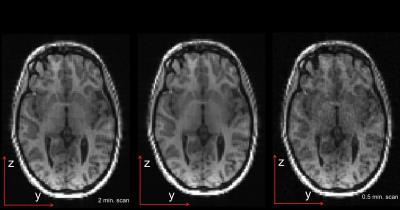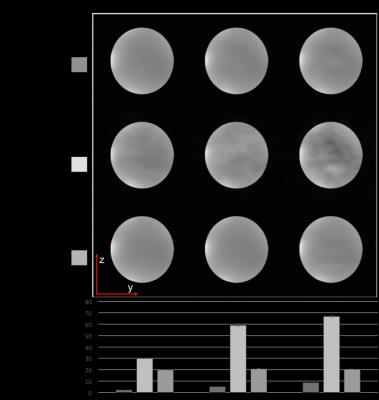1424
Image quality impact of randomized sampling trajectories: implications for compressed sensing1Biomedical Engineering, University of Calgary, Calgary, AB, Canada, 2Seaman Family MR Centre, Foothills Medical Centre, Calgary, AB, Canada, 3Radiology, University of Calgary, Calgary, AB, Canada, 4GE Healthcare, Calgary, AB, Canada
Synopsis
Compressed sensing (CS) has the potential to drastically reduce MR acquisition times,
Purpose
MRI provides exceptional soft tissue contrast but is limited by long acquisition times that can impede visualization of dynamic physiology, increase susceptibility to motion artifacts, and reduce temporal efficiency of routine clinical scans. Recent advances suggest that sparse sampling and non-linear image reconstruction, termed compressed sensing (CS), can create near-perfect images from fewer samples than are typically required.1 CS is applicable to all pulse sequences and contrasts, however image quality of prospectively implemented CS is not as good as predicted by retrospectively under-sampled data (Figure 1). We hypothesize this is due to the effects of eddy currents resulting from the randomized k-space trajectories appropriate for CS. Here, we show the existence of detrimental interactions in full but randomly-sampled k-space data, quantify these interactions in under-sampled CS image reconstruction, and demonstrate a method to mitigate their effects.Methods
All data were acquired on a 3 T scanner (GE Discovery MR750) using a spherical phantom and normal volunteers with a 3D spoiled gradient-echo sequence. Three different fully-sampled encoding schemes were used to test image sensitivity on sampling order: 1) linear kz then ky; 2) randomized kz, then linear ky; and 3) randomized ky and kz. Repetition times (TR) of 4 ms and 16 ms were used with all three schemes. Linear and randomized k-space sampling trajectories were randomly under-sampled to demonstrate the effect of k-space trajectory on sparse image reconstruction for increasing under-sample rates. Randomized, under-sampled k-space trajectories were also sorted to minimize overall trajectory length (Figure 2). Under-sampled images were reconstructed using a sparseSENSE image model consisting of wavelet and total variation l1-norm constraints,2 and resulting artifact level within the phantom in under-sampled images was quantified with root-mean-square (rms) error relative to a fully-sampled reference image.Results
Artifact increased as k-space sampling order became increasingly randomized (Figure 3). However, increasing TR dramatically decreased artifact for each collection pattern and artifact was independent of sampling order at TR equal to 16 ms (not shown). As under-sampling rates increased, prospectively randomized k-space trajectories showed increasing artifact and rms error compared to retrospectively under-sampled linear data (Figure 4). Minimizing the overall k-space trajectory length largely reduced these artifacts, decreased rms error, and improved image quality (Figure 4).Discussion and Conclusion
Our results suggest that TR periods are coupled and this has implications for compressed sensing. This coupling may be due to the induction of eddy currents during phase encoding that propagate into subsequent TR periods causing errors in k-space encoding. Randomized k-space trajectories may be specifically sensitive to errors because eddy currents may vary strongly between adjacent k-space points, inconsistently disrupting phase encoding compared to linear trajectories. We conclude that the acquisition order, not just the sampling mask, of MR data is important for image quality. This could explain the decreased image quality of prospectively implemented CS relative to retrospectively downsampled data (Figure 1). Sorting the acquisition order to minimize the total k-space trajectory length mitigates this issue as evidence by reduced rms error and visually improved image quality relative to fully randomized trajectories. Our work emphasizes an important practical consideration for under-sampled reconstruction, and we have demonstrated a simple but effective method to reduce artifacts resulting from random k-space sampling.Acknowledgements
This work was supported by the The Natural Science and Engineering Research Council (NSERC) of Canada.References
[1] M. Lustig, D. Donoho and J. Pauly, ‘Sparse MRI: The application of compressed sensing for rapid MR imaging’, Magnetic Resonance in Medicine, vol. 58, no. 6, pp. 1182-1195, 2007.
[2] K. F. King, “Combining Compressed Sensing and Parallel Imaging,” in International Society of Magnetic Resonance Medicine, Toronto, ON, 2008, pp. 1488.
Figures



